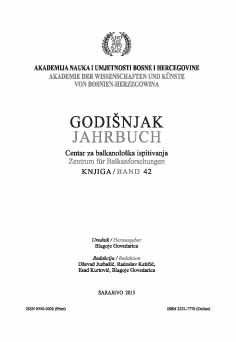Balkanski grad u osmanskom periodu (XV i XVI stoljeće)
Balkan city in the Ottoman period (15th–16th century)
Author(s): Behija ZlatarSubject(s): History
Published by: Akademija Nauka i Umjetnosti Bosne i Hercegovine
Summary/Abstract: Arrival of the Ottomans to the Balkans has witnessed major changes in the development of cities in the area. They have played particularly important role in the construction of new as well as in the changes of existing late antique and medieval towns and their adaptation to Islamic civilization which they brought. The uniqueness of these cities is that they were densely populated with predominantly Muslim population; they had monumental Islamic buildings and a large bazaar where a variety of crafts were developed. Ottoman cadastral records (defteri) show that over 200 cities were in the Balkans in the second half of the fifteenth and sixteenth century. Example of Sarajevo reveals a concept planned established city – residence, which Gazi Isa Bey started to build on the shores of Miljacka by his endowments and numerous other officials, wealthy merchants, artisans and other citizens of Sarajevo continued, including the particularly important role of Gazi Husrev Bey. His complex of buildings still witnesses the planned construction, which was aimed to transform this city not only to administrative but also economic, educational and cultural centre of Bosnia. When we talk about cities in the Balkans in the Ottoman period, it is necessary to speak about the role of waqfin the creation and development of urban settlements. Raising the waqf facilities for various purposes, began with the urban formation of the citysettlements, and further development of waqf buildings served as the basis of that development. Waqf were established by province governors, military commanders and other officials of the Ottoman Empire, as well as wealthy merchants and artisans. Balkan cities population was in the rise in the fifteenth century, and during the sixteenth century it was doubled. Most of the city’s population were Muslims. They were not, as is often thought, mostly officers and soldiers of the Ottoman Empire or foreigners, but the majority of the urban population were local people, artisans and merchants, and various officers. Sarajevo has been developed within one civilization, along with other cities in the Balkans. The most intensive development of Sarajevo during the Ottoman period was in the sixteenth century, so it became the largest and most important city in Bosnia and one of the major cities in the Balkans. All characteristics of an Islamic Ottoman town, both in urban development, division into two zones of housing and economic (mahala – bazaar), as well as the development of trade and their guilds and development of trade, were expressed. It was the administrative, economic, cultural and educational center of the Bosnian Sanjak, later eyalet.
Journal: Godišnjak Centra za balkanološka ispitivanja
- Issue Year: 2013
- Issue No: 42
- Page Range: 135-140
- Page Count: 6
- Language: Bosnian

